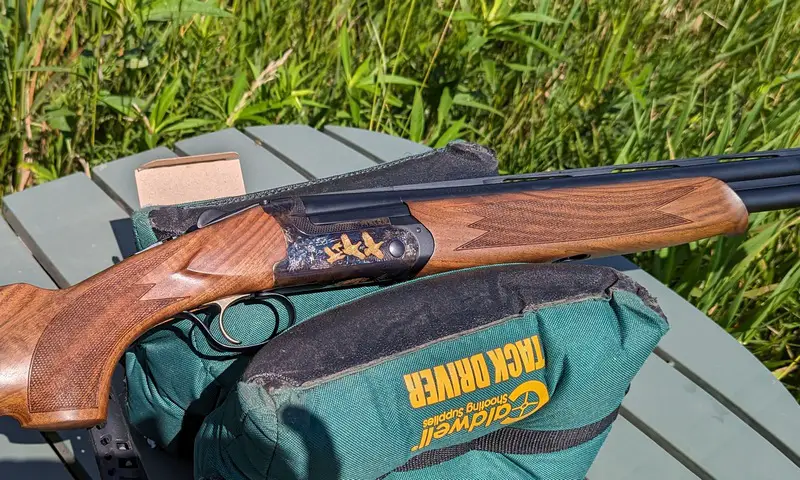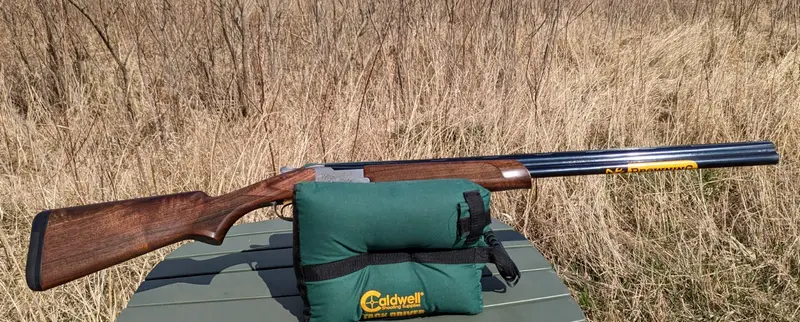|
Shotguns: O/U or Semi-Auto?  Fabarm Elos 2 Elite, photo by Randy Wakeman To be clear, there are potential headaches with both-- enough to make either one potentially unusable. I'll try to list a few pros and cons of both approaches. BARREL REGULATION Barrel regulation is one of most heinous potential problems associated with doubles. I'll quote Bruce Buck. “Beretta’s standard of 7.88″ at 30 meters is shameful. That would approach 10″ at 40 yards. If you use Warren Johnson’s most excellent “Choke Chooser” pattern analyzer you will note that a maximum legal load of #7-1/2s on an edge-on target at 40 yards has AT BEST a 12″ killing pattern. Do you really want to give up 10″ of your 12″ pattern?” It isn't that semi-autos are immune from point of impact problems, either. One of the greatest offenders in current production is the Benelli SBE3 and Ethos models, as in crazy high and to the left. It has been a well-known problem for several years, yet Benelli refuses to address it. TRIGGERS A quality double will give you lighter, crisper, more repeatable trigger pulls. When a trigger group is constructed by sticking pins using a plastic block as opposed to a steel frame, you can only expect so much without some hand tuning. CAPACITY The third shot with a magazine limiter installed makes it a lot easier for triples with a semi-auto on a busy dove field or in the duck blind. LOADING For volume shooting, it is far easier just to continuously feed shells into an autoloader, and far less cumbersome in a tight blind as well. RELIABILITY There can be no “Benelli Click” with an O/U, no feed-up problems, and no ejection problems that can turn your double into a single shot. The edge in reliability and durability generally goes to a quality double. However, no shotgun can be more reliable than the ammunition itself. VERSATILITY With interchangeable barrels, your semi-auto can go from a goose gun to a turkey gun quite easily. With a drilled and tapped semi-auto, optics are easily added for slug use or turkey hunting as well. The semi-auto wins the versatility contest going away. Extended tubular magazines can make your semi-auto better suited as a defense gun or a snow goose gun as well. RECOIL With the 30% or so recoil reduction of a gas-operated semi-auto, the recoil competition for guns of equivalent weight is won by the gas-operated semi-automatic. PRICE and VALUE To discuss price and value, it is necessary to touch on the cost of production. The cheapest repeater to make, by far, is the inertia gun: the Bruno Civolani action and its variants. The action is a split bolt and two springs. Lacking action bars or any gas system, it is just as cheap to make as a pump gun: cheaper than a steel receiver pump gun. Due to the widespread proliferation of cheap inertia guns, the future of the pump shotgun as a hunting shotgun is bleak. The complete demise of the Browning BPS line is a vivid example of this. Another factor is the stock: it can be selected walnut, dried, machined, checkered, and finished. Or, it can be blow-molded thermoplastic that costs several pennies worth of little melt-able beads from ground up garbage can lids and melted milk jugs. Another factor is the cost of labor, including independent proof-testing by a CIP proof house. For non-CIP shotguns, the consumer is forced to just take their word for it. That's a horror movie we have all seen before, from Firestone tires to Takata airbags, to Ford Pinto gas tanks to the Boeing 737 Max. From a basic functional standpoint, a plastic-stocked
inertia shotgun by virtue of its extremely low production cost
offers the most bang for the fewest dollars. With a plastic
stock and hydro-dipped camo or Cerakoted metal, there is next
to nothing as far as exterior maintenance required. While
adjustment shims do nothing more than change the angle of the
buttstock as it protrudes from the back of the receiver, they
still can improve fit to a small degree. It is best, at least
for me, if you need a bit more drop. Few people waste time
arguing if their plastic stock has more figure than another
plastic stock, and few are confused as to how to care for it.
 An example of very good quality CIP proofed inertia semi-automatic shotguns are the Weatherby Sorix (above) and Weatherby 18i lines, along with the Sauer SL5 line. They are both made in Italy with 10 year warranties. A Weatherby Sorix runs $1300 or so street price in 2024. The cost of entry for a good quality O/U is higher as a matter of course. Walnut stocks are generally standard: beyond that you are essentially buying two guns: two barrels, two sears, and steel receivers all of which take more time and effort to produce well. Barrel regulation is critical, for no one wants a second barrel that throws patterns eight inches away from the first . . . only to be told “er, it is within our tolerances.”  Good quality O/U's include the Fabarm Elos 2 Elite (also the Orvis Fabarm D2) that start at $3199 and also the Browning 725 Field / 725 Feather (Field shown above) that starts at $2500. Both have good barrel regulation, a mission critical attribute of O/U shotguns. Have fun this season! |